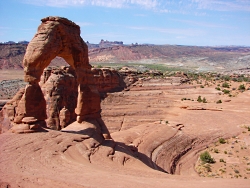
Photo Courtesy & Copyright
Mark Larese-Casanova
Hi, this is Mark Larese-Casanova from the Utah Master Naturalist Program at Utah State University Extension.
The Dynamic History of Arches
A “bow-legged pair of petrified cowboy chaps” is how Edward Abbey once described Delicate Arch, that timeless example of Utah’s peculiar geology. In fact, it’s become such an icon that we see it on automobile license plates throughout the state. What we might not realize, though, is that there is nothing ‘timeless’ about Utah’s arches at all.
To help us understand this, let’s go back in time about 300 million years ago. At that time, inland seas routinely flowed into eastern Utah and evaporated, leaving behind a layer of salt that, in some places, is thousands of feet thick. During the next 200 million years, winds, oceans, and rivers deposited a rainbow of sediment layers in southern Utah. These sediments were eventually cemented into sandstones, limestones, and other sedimentary rocks.

Learn How Nature Builds an Arch
Graphic Courtesy
US National Parks Service
Under the weight of all of these rock layers, along with the gradual uplift of the Colorado Plateau around 10 million years ago, the unstable salt layer below flowed like toothpaste. This caused the rock layers above to shift and buckle. Think of it as trying to build a brick house on top of a bed of mud- you would eventually have a house full of cracks.
In some areas, many parallel cracks formed at the surface, and as water flowed into these cracks, the sandstone eroded into tall vertical fins. Some of the fins collapsed over time, and some eroded in just the right way to form an arch. Arches continue to erode and will eventually collapse. But, at the same time, new arches will always form.
There are over 2,000 catalogued arches just within Arches National Park. That’s a lot of arches within such a small area! Within the park, most of the arches have formed in the red, iron-rich Entrada sandstone, however the tan Navajo sandstone also has several. Other rock formations to be seen include spires, mesas, windows, natural bridges, and balanced rocks.
To learn more about Utah’s amazing geologic history, visit Arches National Park’s website at nps.gov/arch or the Utah Geological Survey’s website at geology.utah.gov. And, make sure to visit and explore Utah’s arches as often as you can. After all, they won’t be around forever…
For Wild About Utah, I’m Mark Larese-Casanova.
Credits:
Images: Courtesy US National Parks Service
Delicate Arch, Courtesy & Copyright Mark Larese-Casanova
Text: Mark Larese-Casanova, Utah Master Naturalist Program at Utah State University Extension.
Additional Reading:
Desert Solitaire, Edward Abbey, https://www.amazon.com/Desert-Solitaire-Edward-Abbey/dp/0671695886
Arches National Park, US National Park Service, US Department of the Interior, www.nps.gov/arch/
Utah Geological Survey, State of Utah, www.geology.utah.gov
